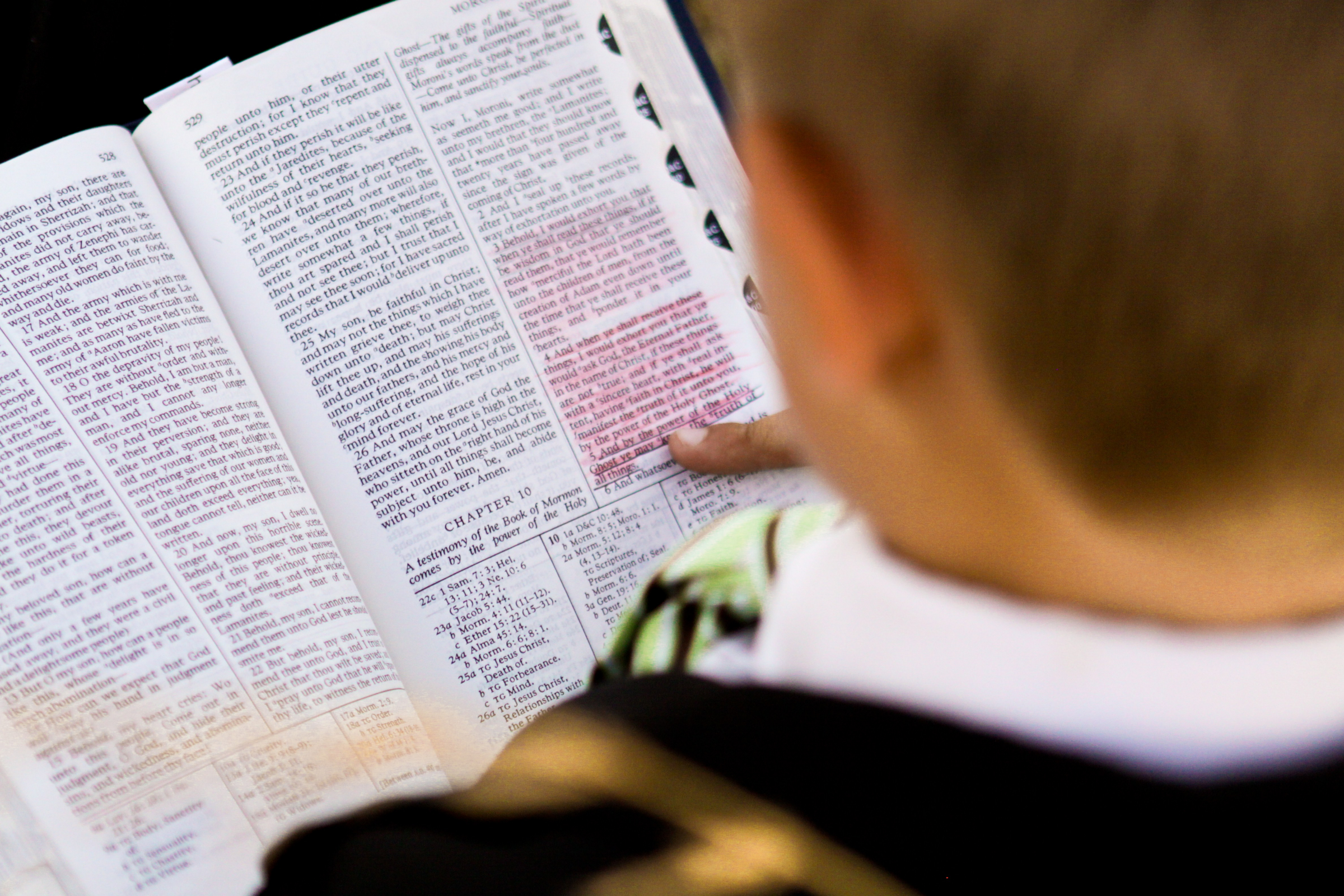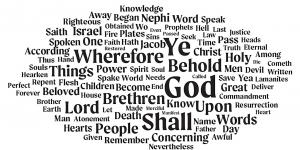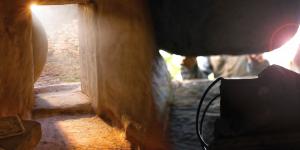You are here
Does Chiasmus Prove Anything about the Book of Mormon?

2 Nephi 11:4
Editor’s Note: This year marks 50 years since the discovery of chiasmus in the Book of Mormon on August 16, 1967. To celebrate this 50th anniversary, through July and August Book of Mormon Central will publish one KnoWhy each week that discusses chiasmus and its significance and value to understanding the Bible, the Book of Mormon, and other ancient literature. Be sure to check out our other KnoWhys on chiasmus and the Chiasmus Resources website for more information.
The Know
Since its discovery in 1967,1 people have wondered what to make of the Book of Mormon’s use of chiasmus. Some have seen its numerous chiasms as compelling evidence of the Book of Mormon’s authenticity. Others have supposed that the presence of this literary feature proves next to nothing. Although what chiasmus proves must ultimately be determined by each individual, carefully evaluating the Book of Mormon’s unique use of this literary style can help readers better assess its overall value as evidence.
Quantity
There are now hundreds of proposed chiasms in the Book of Mormon.2 If they were spread out evenly over the entire text, a chiasm would show up on virtually every page. Undoubtedly, these numerous chiasms have varying degrees of legitimacy, but their sheer quantity makes it less likely that they are collectively a product of random chance.
Sophistication
Many of the Book of Mormon’s chiasms show up as orderly, complex, and precise textual units that comply well with criteria used by both LDS and non-LDS scholars.3 Sound statistical analysis has even demonstrated that several of these more sophisticated chiasms are highly unlikely to have occurred by random chance,4 especially when they are grouped collectively.5 The Book of Mormon’s chiasms often thematically and symbolically enrich their authors’ primary messages in memorable ways, indicating that they cared about more than mere cleverness of form.6
Multiple Authors
Those Book of Mormon authors who frequently used chiasmus often did so in distinctive ways.7 When Nephi wrote about his family’s journey to the promised land, he did so many years after the events took place. This apparently gave him time to carefully rework the narrative events into multiple chiastic structures,8 which he then embedded into an overarching chiasm spanning the entirety of 1 Nephi.9 Nephi’s chiastic memoirs can be meaningfully contrasted with King Benjamin’s use of chiasmus, which was “quite classical and pure,” and also with Alma’s use, which was “much more creative and personal.”10 Other Book of Mormon authors, like Abinadi, seem to have rarely used this literary form.11
Ancient Hebrew Origins
The Nephite prophets claimed to perpetuate the religious and literary traditions of their Hebrew ancestors (see 1 Nephi 3:19). This is significant because chiasmus was arguably a “dominant, if not essential, element of Hebrew writing” during Lehi’s day.12 If such a frequently used Hebrew form were to be absent from the Nephite text, it might reasonably be seen as a “glaring deficiency.”13 Yet generally speaking, the Book of Mormon’s use of chiasmus nicely matches the high frequency and unique style of its use in the Bible.
For example, the “embodiment of the ancient Israelite concept of justice” found in Leviticus 24:13–23 is similarly modeled in Alma 41:13–15, and chiasms such as Helaman 6:7–13 contain parallel words and phrases that work even better if the underlying text was derived from Hebrew.14 Although more extensive comparisons are needed, Welch concluded, “If the absence of chiasmus would be inconsistent with its claim of Israelite origins, then the presence of chiasmus in the Book of Mormon is, at least to an equal extent, evidence corroborating that claim.”15
Ancient American Origins
The Israelites weren’t the only ancient civilization to extensively use chiasmus.16 This literary form also shows up in Mayan texts, and is thought by scholars to be part of ancient America’s earliest poetic tradition.17 In several ways, the Book of Mormon’s use of chiasmus is quite similar to its use in ancient Mayan texts,18 demonstrating that it nicely fits its claimed ancient literary settings in both the Old and New Worlds.
The Why
Some have argued that the Book of Mormon’s use of chiasmus is inconsequential because chiasms sometimes show up randomly in a text—for instance, in a computer manual, where its presence was obviously unintentional.19 Others have felt that chiasmus is simply not special or unique because it has been used in children’s books like Green Eggs and Ham, in nursery rhymes like “Hickory Dickory Dock,” and other forms of English prose and poetry.20 It has even been proposed that Joseph Smith discovered chiasmus through his own reading of the Bible or that he drew upon obscure chiasmus-related biblical research to help him fabricate the Book of Mormon.
Yet in one way or another, each of these explanations is lacking. For decades now, scholars of the Bible and the Book of Mormon have recognized that chiasmus can sometimes occur by chance. That is what has led to the rigorous criteria and statistical models that have been used to test a chiasm’s overall strength.21 Many chiasms in the Book of Mormon have passed these tests with flying colors.22
And although nursery rhymes and other forms of English poetry demonstrate various chiasmus-related structures, there would have been little reason for Joseph Smith to assume that such structures were used extensively in Hebrew-related texts like the Bible. John W. Welch has found that even many biblical scholars today “are not aware, either consciously or subconsciously, of the chiastic structure of biblical text.”23 The fact that no one noticed or mentioned the presence of chiasmus in the Book of Mormon for more than 130 years after its publication is pretty good evidence that the vast majority of readers do not detect these structures unless they are pointed out for them.
Joseph Smith’s limited education makes him an especially poor candidate to simply stumble upon this literary form’s association with ancient Hebrew literature,24 whether on his own or through reading obscure, higher-level academic research.25 Even if he had made such discoveries, the high quantity of high quality chiasms in the Book of Mormon seem to be well beyond any amateur attempt at adapting nursery rhymes or mimicking what was then known of biblical parallelisms. It should also be noted that several dozen other types of Hebrew literary forms are also used extensively throughout the Book of Mormon, making chiasmus just the flagship in an entire fleet of Hebrew-related literary evidences.26
In the approximately 74-day process of orally dictating the Book of Mormon to various scribes,27 Joseph Smith seamlessly integrated hundreds of instances of chiasmus—and well over a thousand instances of other varied Hebrew literary forms28—into an already demonstrably complex and consistent text.29 According to scribes and witnesses, he accomplished this without any major revisions and without relying on any working notes or reference materials of any kind.30 Such a feat is nothing short of miraculous.31
The Book of Mormon’s extensive and unique use of chiasmus offers very good evidence that its text is orderly, complex, consistent, and beautiful. It is evidence that it was written by multiple authors who carefully implemented this literary style on certain types of occasions and for particular purposes. It is evidence that whoever wrote the Book of Mormon was likely very familiar with the use of chiasmus in the ancient word, especially by Hebrew writers in ancient Israel and perhaps even by Mayan writers in ancient America. And when viewed collectively, it offers good evidence that Joseph Smith was telling the truth about the Book of Mormon’s miraculous discovery and translation.
Further Reading
Boyd F. Edwards and W. Farrell Edwards, “Does Chiasmus Appear in the Book of Mormon by Chance?” BYU Studies Quarterly 43, no. 2 (2004): 103–130.
John W. Welch, “What Does Chiasmus in the Book of Mormon Prove?” in Book of Mormon Authorship Revisited: The Evidence for Ancient Origins, ed. Noel B. Reynolds (Provo, UT: FARMS, 1997), 199–224.
John W. Welch, “Chiasmus in the Book of Mormon,” Ensign, February 1972, online at lds.org.
- 1. See Book of Mormon Central, “How Was Chiasmus Discovered in the Book of Mormon? (Mosiah 5:11),” KnoWhy 353 (August 16, 2017).
- 2. See “Chiasmus Index, Book of Mormon,” online at chiasmusresources.org; Donald W. Parry, Poetic Parallelisms in the Book of Mormon: The Complete Text Reformatted (Provo, UT: Neal A. Maxwell Institute for Religious Scholarship, 2007), 565.
- 3. See John W. Welch, “Criteria for Identifying and Evaluating the Presence of Chiasmus,” Journal of Book of Mormon Studies 4, no. 2 (1995): 1–14; republished for a mainstream audience as John W. Welch, “Criteria for Identifying and Evaluating the Presence of Chiasmus,” in Chiasmus Bibliography, ed. John W. Welch and Daniel B. McKinley (Provo, UT: Research Press, 1999), 157–174. See also, “Chiasmus Criteria,” online at chiasmusresources.org. For analysis of Book of Mormon chiasms that comply well with these criteria, see Book of Mormon Central, “What Can We Learn from Ten of the Best Chiasms in the Book of Mormon? Part 1 (2 Nephi 25:26),” KnoWhy 349 (August 7, 2017); Book of Mormon Central, “What Can We Learn from Ten of the Best Chiasms in the Book of Mormon? Part 2,” KnoWhy 352 (August 14, 2017); Book of Mormon Central, “What Can We Learn from Ten of the Best Chiasms in the Book of Mormon? Part 3 (Alma 36:18),” KnoWhy 355 (August 20, 2017).
- 4. Boyd F. Edwards and W. Farrell Edwards, “Does Chiasmus Appear in the Book of Mormon by Chance?” BYU Studies 43, no. 2 (2004): 118–120.
- 5. Boyd F. Edwards and W. Farrell Edwards, “Response to Earl Wunderli’s Critique of Alma 36 as an Extended Chiasm,” Dialogue: A Journal of Mormon Thought, Dialogue Paperless: E-Paper #1 (April 30, 2006): 5, also see n. 17.
- 6. For several examples, see Book of Mormon Central, “Why Did Nephi Use Chiasmus to Testify of Christ? (2 Nephi 11:3),” KnoWhy 271 (Febrary 6, 2017); Book of Mormon Central, “Why Did King Benjamin Use Poetic Parallels So Extensively? (Mosiah 5:11),” KnoWhy 83 (April 21, 2016); Book of Mormon Central, “Why Was Alma Converted? (Alma 36:21),” KnoWhy 144 (July 15, 2016); Book of Mormon Central, “Why and How Did Alma Explain the Meaning of the Word ‘Restoration’? (Alma 41:1),” KnoWhy 149 (July 22, 2016); Book of Mormon Central, “Why Was Chiasmus Used in Nephite Record Keeping? (Helaman 6:10),” KnoWhy 177 (August 31, 2016).
- 7. The fact that Book of Mormon authors used chiasmus in different ways and with varying frequencies supports sound stylometric (sometimes called “wordprint”) studies of the text, which indicate that it was written by multiple authors. See Matthew Roper, Paul J. Fields, and G. Bruce Schaalje, “Stylometric Analyses of the Book of Mormon: A Short History,” Journal of the Book of Mormon and Other Restoration Scripture 21, no. 1 (2012): 28–45. For the varying use of Hebrew parallelisms in the Book of Mormon generally, see Carl J. Cranney, “The Deliberate Use of Hebrew Parallelisms in the Book of Mormon,” Journal of Book of Mormon Studies 23 (2014): 140–165.
- 8. See David E. Sloan, “Nephi’s Convincing of Christ through Chiasmus: Plain and Precious Persuading from a Prophet of God,” Journal of Book of Mormon Studies 6, no. 2 (1997): 67–98; Dennis Newton, “Nephi’s Use of Inverted Parallels,” Interpreter: A Journal of Mormon Scripture 22 (2016): 79–106.
- 9. See John W. Welch, “Chiasmus in the Book of Mormon,” Ensign, February 1972, online at lds.org; Noel B. Reynolds, “Nephi’s Outline,” in Book of Mormon Authorship: New Light on Ancient Origins, ed. Noel B. Reynolds (Provo, UT: Religious Studies Center, Brigham Young University, 1982), 53–74.
- 10. John W. Welch, “What Does Chiasmus in the Book of Mormon Prove?” in Book of Mormon Authorship Revisited: The Evidence for Ancient Origins (Provo, UT: FARMS, 1997), 211.
- 11. See Welch, “What Does Chiasmus in the Book of Mormon Prove?” 211.
- 12. Welch, “What Does Chiasmus in the Book of Mormon Prove?” 213.
- 13. Welch, “What Does Chiasmus in the Book of Mormon Prove?” 214.
- 14. Welch, “What Does Chiasmus in the Book of Mormon Prove?” 215.
- 15. Welch, “What Does Chiasmus in the Book of Mormon Prove?” 214.
- 16. See Book of Mormon Central, “How Did Biblical and Ancient Near Eastern Authors Use Chiasmus? (Alma 34:9),” KnoWhy 340 (July 16, 2017).
- 17. Kerry M. Hull, “Poetic Tenacity: A Diachronic Study of Kennings in Mayan Languages,” in Parallel Worlds: Genre, Discourse, and Poetics in Contemporary, Colonial, and Classic Maya Literature, ed. Kerry M. Hull and Michael D. Carrasco (Boulder, CO: University Press of Colorado, 2012), 73.
- 18. See Book of Mormon Central, “Was Chiasmus Known to Ancient American Writers? (Alma 29:4),” KnoWhy 346 (July 31, 2017).
- 19. See Boyd F. Edwards and W. Farrell Edwards, “Does Chiasmus Appear in the Book of Mormon by Chance?” BYU Studies Quarterly 43, no. 2 (2004): 105–106.
- 20. See Boyd F. Edwards and W. Farrell Edwards, “When Are Chiasms Admissible as Evidence?” BYU Studies 49, no. 4 (2010): 134.
- 21. See Book of Mormon Central, “What Counts As Chiasmus? (1 Nephi 19:7),” KnoWhy 337 (July 17, 2017).
- 22. See Book of Mormon Central, “What Can We Learn from Ten of the Best Chiasms in the Book of Mormon? Part 1 (2 Nephi 25:26),” KnoWhy 349 (August 7, 2017); Book of Mormon Central, “What Can We Learn from Ten of the Best Chiasms in the Book of Mormon? Part 2,” KnoWhy 352 (August 14, 2017); Book of Mormon Central, “What Can We Learn from Ten of the Best Chiasms in the Book of Mormon? Part 3 (Alma 36:18),” KnoWhy 355 (August 20, 2017).
- 23. Welch, “What Does Chiasmus in the Book of Mormon Prove?” 219.
- 24. For Joseph Smith’s limited literary ability and education, see Robert A. Rees, “John Milton, Joseph Smith, and the Book of Mormon,” BYU Studies Quarterly 54, no. 3 (2015): 6–18; Robert A. Rees, “Joseph Smith, the Book of Mormon, and the American Renaissance: An Update,” Interpreter: A Journal of Mormon Scripture 19 (2016): 1–16; Robert A. Rees, “Joseph Smith, the Book of Mormon, and the American Renaissance,” Dialogue: A Journal of Mormon Thought 35, no. 3 (2002): 83–112. John W. Welch, “The Miraculous Timing of the Translation of the Book of Mormon,” in Opening the Heavens: Accounts of Divine Manifestations 1820–1844, 2nd edition, ed. John W. Welch (Salt Lake City and Provo, UT: Deseret Book and BYU Press, 2017), 90; Richard Lloyd Anderson, “The Preparation of the Prophet Joseph Smith,” Ensign, December 2005, online at lds.org.
- 25. See Book of Mormon Central, “How Much Could Joseph Smith Have Known about Chiasmus in 1829? (1 Nephi 3:19),” KnoWhy 334 (July 3, 2017).
- 26. See Donald W. Parry, Poetic Parallelisms in the Book of Mormon: The Complete Text Reformatted (Provo, UT: Neal A. Maxwell Institute for Religious Scholarship, 2007) xii–xlvi; Donald W. Parry, “Hebraisms and Other Ancient Peculiarities in the Book of Mormon,” in Echoes and Evidences of the Book of Mormon, ed. Donald W. Parry, Daniel C. Peterson, and John W. Welch (Provo, UT: FARMS, 2002), 155–189. Hugh W. Pinnock, Finding Biblical Hebrew and Other Ancient Literary Forms in the Book of Mormon (Provo, UT: FARMS, 1999).
- 27. Welch, “The Miraculous Timing of the Translation of the Book of Mormon,” 119.
- 28. See Parry, Poetic Parallelisms in the Book of Mormon, 569–578; David E. Bokovoy and John A. Tvedtnes, Testaments: Links Between the Book of Mormon and the Hebrew Bible (Tooele, UT: Heritage Press, 2003), 202–229.
- 29. See Melvin J. Thorne, “Complexity, Consistency, Ignorance, and Probabilities,” in Book of Mormon Authorship Revisited, 179–193; Grant Hardy, Understanding the Book of Mormon: A Reader’s Guide (New York, NY: Oxford University Press, 2010), 6–7.
- 30. See Royal Skousen, “How Joseph Smith Translated the Book of Mormon: Evidence from the Original Manuscript,” Journal of Book of Mormon Studies 7, no. 1 (1998): 24; “Last Testimony of Sister Emma,” The Saint’s Herald 26, no. 19 (October 1, 1879): 289–290.
- 31. See Book of Mormon Central, “Why Did the Book of Mormon Come Forth as a Miracle? (2 Nephi 27:23),” KnoWhy 273 (February 10, 2017).
KnoWhy Citation
Related KnoWhys
Subscribe
Get the latest updates on Book of Mormon topics and research for free





